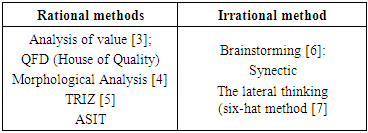-
Paper Information
- Paper Submission
-
Journal Information
- About This Journal
- Editorial Board
- Current Issue
- Archive
- Author Guidelines
- Contact Us
American Journal of Intelligent Systems
p-ISSN: 2165-8978 e-ISSN: 2165-8994
2017; 7(1): 31-38
doi:10.5923/j.ajis.20170701.03

Tools Form Managing an Entreprise’s Innovation Process
Meriem Ben Miloud 1, Yasmina Kerboua Ziari 2
1National School of Statistics and Applied Economics, Algier, Algeria
2University of Science and Technology Houari Boumediene, Algier, Algeria
Correspondence to: Meriem Ben Miloud , National School of Statistics and Applied Economics, Algier, Algeria.
| Email: |  |
Copyright © 2017 Scientific & Academic Publishing. All Rights Reserved.
This work is licensed under the Creative Commons Attribution International License (CC BY).
http://creativecommons.org/licenses/by/4.0/

In the face of increasing competition and rapidly evolving markets, innovation is one of the essential components of business competitiveness. The complex process of innovation involves the company and its environment, and must be organized in order to guarantee its performance and sustainability. Engaging in an innovation process is far from easy for the company. Complex, generating and using a large amount of information, this process must be optimized to satisfy a precise need and bring comfort of choice of solutions. Information is an indispensable resource for the proper management of this process and the setting up of an information system, will allow to adapt a precise and effective methodology to understand the needs of the customers to whom the innovative product is intended.
Keywords: Information System, UML, Creativity, Idea Filtering, Innovation, Innovation Process
Cite this paper: Meriem Ben Miloud , Yasmina Kerboua Ziari , Tools Form Managing an Entreprise’s Innovation Process, American Journal of Intelligent Systems, Vol. 7 No. 1, 2017, pp. 31-38. doi: 10.5923/j.ajis.20170701.03.
Article Outline
1. Introduction
- The evolution of any business depends on its ability to compete. Globalization has forced companies, to challenge themselves in order to be competitive and resist international competition. These companies are then in the situation to either innovate or disappear from the market. Indeed, among the means allowing the company to achieve these objectives, innovation presents itself as a strategic lever to acquire a competitive advantage and meet the needs of the market. Companies that innovate quickly and successfully are now those who have mastered their innovation process. It is then necessary to propose models for the elaboration of an innovation which allows to describe, understand and then to pilot the innovation in an optimal way taking into account the specificities relating to the object of the innovation. However, initiating such a process is very challenging. In fact, information is an expensive resource to manage this process. The implementation of its system makes it possible to adapt a precise and effective methodology to understand the needs of the customers to whom the innovative product is intended. In a first step, we have detailed the process of the innovation process. For each step we have presented the different methods and tools necessary for their realization [1]. After having identified all the information inherent in the process, we designed an information system for the management of the innovation process.The main objectives of such a system are:- Ensure an effective management of all the collected ideas (as well as the information gathered).- Discard the uncertain ideas of achieving a commercial success in a preliminary stage, in order to limit the investments of the company.- Assist decision-makers in gaining greater visibility into the feasibility of an idea.
2. Innovation Process
- For an enterprise change in the products or functions to be considered as an innovation, it must be new to or leads to a significant improvement. The concept of innovation is directly related to that of the organization and virtually all of the company's projects are originally based on an innovation [10]. However, others define innovation as the product of a specific activity as DURIEUX [11] for whom 'Innovation is content before being a process'. Different definitions of the concept appears in the technical and scientific literature (under the field of automation or management) (Bescos and Mendoza [13], Lemoigne, Lorino, Vernadat, [14, 15, 16], Haurat and Théroude, [17]). The innovation process we have proposed is structured into three major phases, where each phase consists of a set of steps as shown in Figure 1:
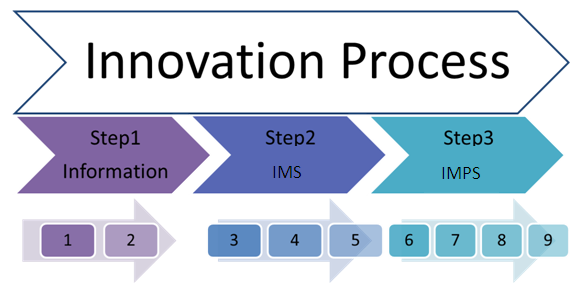 | Figure 1. Innovation process |
2.1. Phase 1: Information
- § Step 1: Raw information gatheringTwo sources types are illustrated herein from which information is relevant to the innovation process where it can be collected: external to markets and competitors, and internal to the company internal environment.§ Step 2: Data filteringOnce the raw information is collected, it must be processed and selected. The selection is mainly based on the external raw information. Among the methods of selection and processing of data, the method proposed by Martinet [2] is used. It consists in classifying the relevant information using the following two parameters:•The information truthfulness probability •The importance of information to the organization.
2.2. Phase 2: IMS - Idea Management System
- § Step 3: Ideas generationIt is important to develop and maintain a culture of innovation in the organization to encourage and motivate all staff to be creative and actively contribute to the innovation process.
2.2.1. Creativity
- Creativity is the ability to produce an original and achievable ideas. This ability is present in every human being. It depends, however, on several factors: flexibility (coming out of established ideas), fluidity (allowing oneself quantity), originality (accepting and seeking shocking ideas), elaboration (considering all practical aspects to realize The idea).
2.2.2. Creativity Methods
- Methods of creativity can be classified into two broad categories: so-called rational methods and so-called non-rational methods. Table 1 illustrates both categories.
|
2.3. Phase3: IPMS - Innovative Project Management System:
- § Step 6: Market researchThe purpose of the market research is to collect quantitative and qualitative information (Related to behavior). Market research is a diagnosis or an "inventory" of the existing one, namely supply, demand and the environment.§ Step 7: PrototypingThe prototype is made by hand. A set of indicators are deduced and synthesized in a document, which will be transmitted to the production department to start the prototype design and production: the number of parts, shape, size...§ Step 8: ProtectionIndustrial protection guarantees against abuse of its innovation and reserves a form of monopoly on its applications. It can reap the rewards of its innovation efforts, taking advantage of the market.§ Step 9: Production and marketingOnce the prototypes finalization is complete, the SME begins the industrialization phase of innovation. The product innovations sales launch must be done through a marketing strategy.
3. Methodology and Design
- There are several design tools and we have chosen UML-based object-oriented modeling, which is a unified and powerful programming language. The RUP process, for which we have opted is an approach that can support the UML tool, its objective is to allow the production of software of a high quality level corresponding to the needs of the end user [13].We propose a schema that illustrates the different tasks for which the IS must perform. However, some tasks remain abstract and need to be described in detail in order to achieve a more complete design.Expression of needs is an important step in the software building process.
3.1. Identification of Actors
- An actor represents the abstraction of a role played by external entities (users, hardware devices or other systems) that interact directly with the system. The actors of the system are:Entrepreneur: It has the right to consult, modify, evaluate and propose ideas and / or information; it is also required to make decisions.External actor (Client / Collaborator / Supplier): He can propose ideas.Employees: Employees have the right to consult relevant information (harvested and sorted), to consult the innovative ideas and to propose ideas.Researcher / Expert of the R & D Unit: He can consult, modify, evaluate and propose ideas and / or information.Administrator: The administrator has the right to create a new user and define the roles and privileges of the users of the system.
3.2. Census of Use Cases
- Functional requirements are based on user requests. These needs are structured in the form of use cases.After studying the innovation process, the most important cases of use that need to be addressed by the proposed system have been identified. They are summarized in Table 2:
|
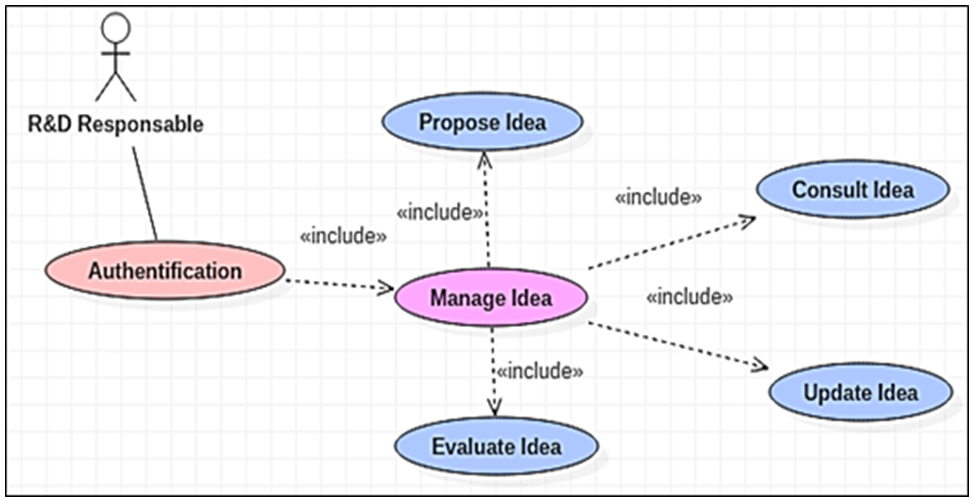 | Figure 2. Use Case Diagram Ideas Management |
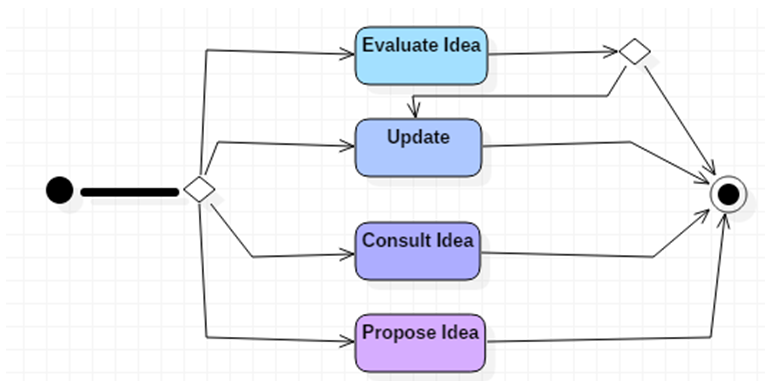 | Figure 3. Activity diagram "Management Ideas" |
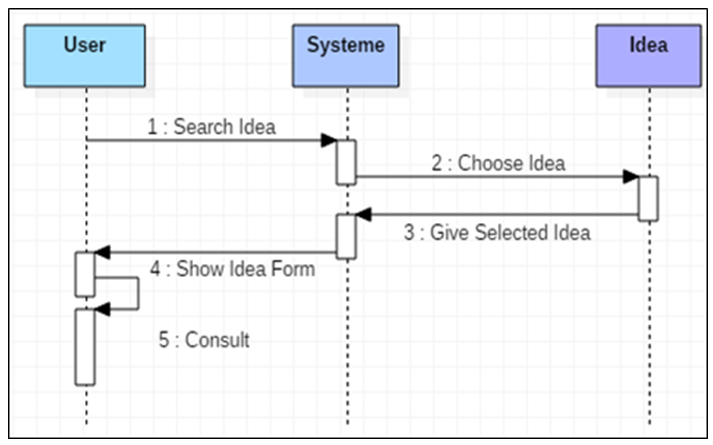 | Figure 4. Sequence Diagram "Idea Consultation" |
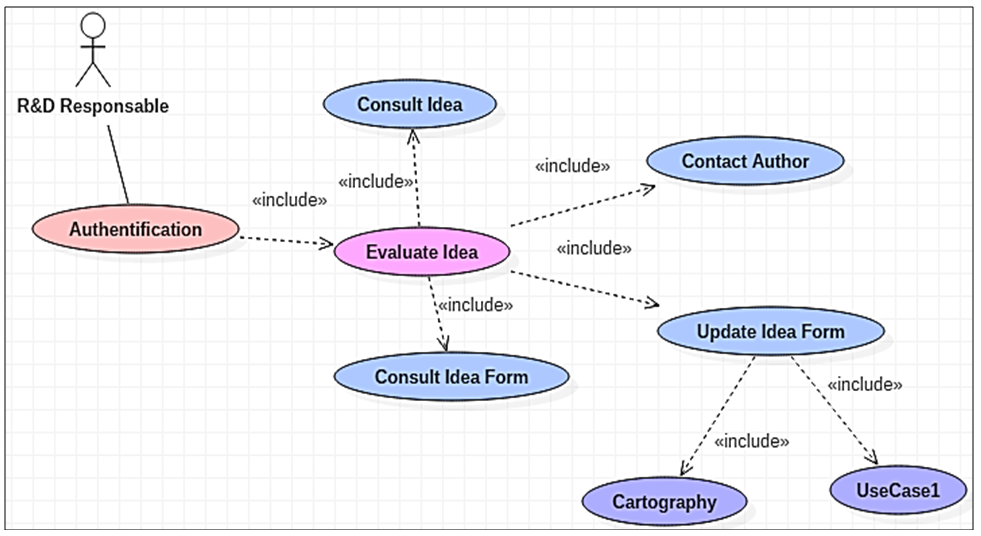 | Figure 5. Diagramme de cas d’utilisation ‘évaluer idée’ |
 | Figure 6. Activity diagram Evaluation Ideas |
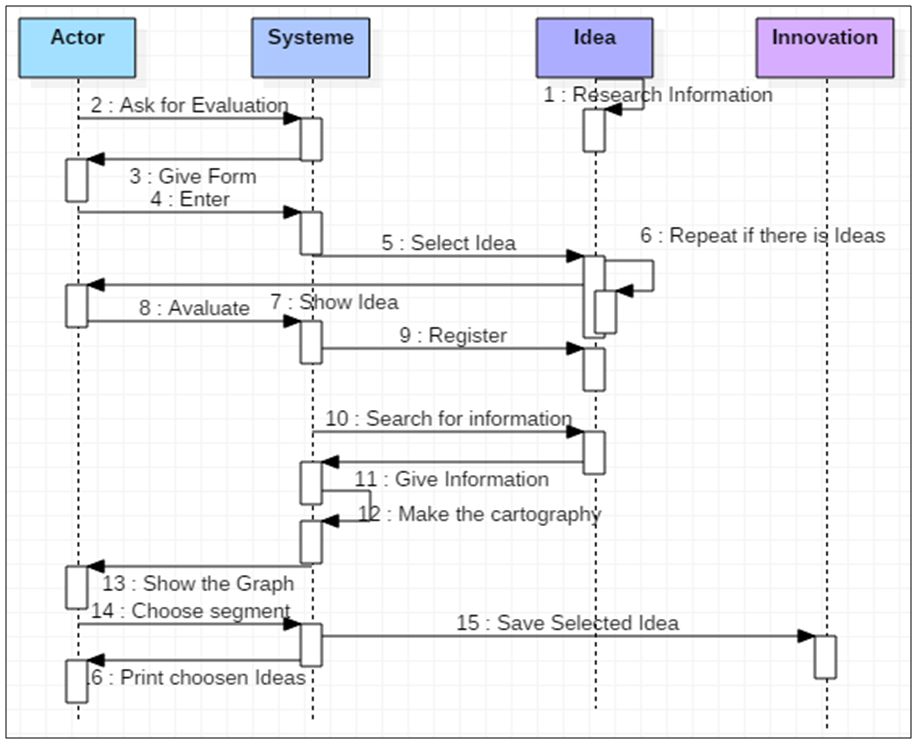 | Figure 7. Diagram of sequence evaluation Idea "O'MEARA" |
4. Dashboard
- A dashboard is a set of indicators to allow managers to learn about the status of the systems they operate and to identify trends that will influence the horizon that is compatible with the nature of their functions. [8]Dashboards (TBs) are management tools, decision support tools that enable administrators to be able to take the pulse of the organization, produce key management information, report and localize problems or abnormal situations, as much as possible in real time, in a comprehensible form. It should also be a prediction tool to extrapolate past trends and gaps in order to understand the future with less uncertainty. It makes it possible to "select, organize, and present the essential and relevant indicators to managers, in the form of a glance with disaggregated or synoptic reports, providing both a global vision and the possibility of forging In detail levels ". According to Voyer [9], a dashboard is a conceptual organizational management framework that must support the document management system (DMS) based on management information system. A dashboard is a decision-making instrument, each decision is a risk-taking. To this end, the design of this instrument must be given great importance. The Innovation Scoreboard is an essential tool for good innovation management. It will become the barometer of innovation director and provides an effective communication tool for management.It is important to define a score card that will track the progress of the innovative project and track any changes. Indicators for the project: planning, tracking of time spent goods sold and different costs. They can integrate criteria external to the company: market trends, behavior of competitors, withdrawal of a partner, changing the regulatory environment ...In the following, we describe a set of indicators which we have defined, constituting a part of the scoreboard in the management of innovation and innovative projects.Identify indicators: Because the dashboard is for people other than the person who grows, choose different display modes that are understandable by users. The main indicators are intended to illustrate the relevant changes in the synthesis of progress in innovation.Customer indicators (satisfaction, number of complaints, after-sales)- The rate of customer satisfaction; - Complaints rateFinancial indicators:- Budget for innovation. Employee indicators; - Creativity rate; Indicators for ideas:- Pricing ideas that led; - Number of ideas evaluated; - Level of creativity of employees; - Level of new compliance product; - Environmental level; - Sources of ideas (internal and external)Linked to the development of innovative projects indicators:- Number of innovative projects underway; - Progress of an innovative project, prototype indicators:- Number of prototypes; - Prototypes validated rates; - Indicator competitors; - Number of competitors- The share of each competitor's market.Supplier relations indicators:- The rate of products delivered by the compliance provider; - Delivery time.
5. Conclusions
- In this paper we were able to structure a company innovation process, where we have demonstrated the contribution and usefulness of an information system for the management of this complex process. We have shown that in order for an organization to innovate with greater reliability, in order to improve competitiveness and to acquire new markets, it is necessary to mobilize the various resources that allow the management of the process 'innovation.The study of the different concepts related to the information systems in the organizations, allowed us to understand the stakes and to know how to apply them in order to design an Information System for an innovation process management. Through this, a detailed description of an innovation process has been developed and has made it possible to design an information system for that purpose. The information system provides a framework for managing a company's innovation management needs. The specifications derivated from the use cases have been formalized in the UML language from the structural point of view with the class diagram and from the dynamic angle with the sequence, transition and activity diagrams.
 Abstract
Abstract Reference
Reference Full-Text PDF
Full-Text PDF Full-text HTML
Full-text HTML